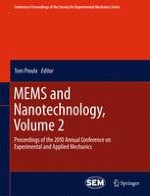2011 | Buch
MEMS and Nanotechnology, Volume 2
Proceedings of the 2010 Annual Conference on Experimental and Applied Mechanics
herausgegeben von: Tom Proulx
Verlag: Springer New York
Buchreihe : Conference Proceedings of the Society for Experimental Mechanics Series
